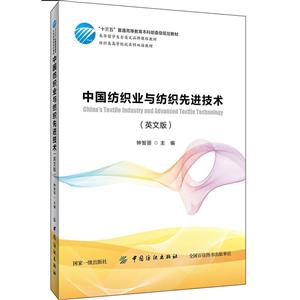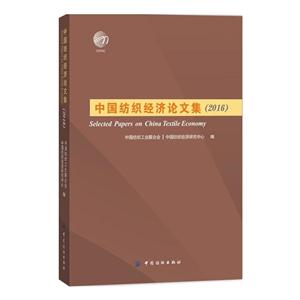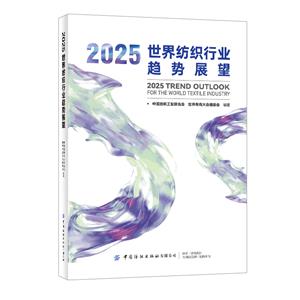
作者:钟智丽
页数:197页
出版社:中国纺织出版社
出版日期:2020
ISBN:9787518058877
电子书格式:pdf/epub/txt
内容简介
本书内容主要包括中国传统纺织文化 ; 新中国纺织业成就 ; “一带一路”与中国纺织发展前景 ; 新型纤维的制备技术及研发进展 ; 先进短纤维纺纱技术 ; 织造技术的数字化、自动化及智能化 ; 智能纺织、高端产业用纺织等纺织前沿技术 ; 先进织物染色及功能处理技术。
作者简介
博士,教授,天津工业大学纺织学院做科研和教学工作,担任天津工业大学纺织商检系主任、纤维材料及应用开发创新团队负责人。主要研究方向:先进纺织材料、高端产业用纺织品、纺织结构复合材料等。
本书特色
本书是“十三五”普通高等教育本科部委级规划教材中
的一种,内容主要包括中国传统纺织文化;新中国纺织业成
就;“一带一路”与中国纺织发展前景;新型纤维的制备技术
及研发进展;先进短纤维纺纱技术;织造技术的数字化、自动
化及智能化;智能纺织品、高端产业用纺织等纺织前沿技术;
先进织物染色及功能处理技术。
本书主要作为纺织类高等院校本科教学用教材,来华留
学英语授课教材,也可供中—英双语授课选作教材或者参考
书,还可为纺织工程高级专业技术人员提供参考
目录
1. 1 Chinese Traditional Clothing ………………………… 1
1. 1. 1 Hanfu …………… 1
1. 1. 2 Ethnic Minority Costumes ……………………… 6
1. 2 National Traditional Craft—hinese Embroidery …… 8
1. 2. 1 Su Embroidery …… 8
1. 2. 2 Yue Embroidery … 9
1. 2. 3 Shu Embroidery … 9
1. 2. 4 Xiang Embroidery 10
1. 3 Chinese Traditional Skills …………………………… 11
1. 3. 1 Weaving Skills of Song Brocade ……………… 11
1. 3. 2 Silk Weaving Skills …………………………… 12
1. 3. 3 Suzhou K�.s-ssu Silk Weaving Skills …………… 13
1. 4 Chinese Traditional Auspicious Patterns …………… 15
1. 4. 1 The Generation of Auspicious Concept ………… 15
1. 4. 2 The Essence of the Concept of Auspicious …… 15
1. 4. 3 The Introduction of Several Common Auspicious Patterns ………… 15
Exercises …………………… 19
References ………………… 19
Chapter 2 The overview of China�.s Textile Industry …… 22
2. 1 The Developing Course and Position of China�.s Textile Industry …… 22
2. 1. 1 The Developing Course of China�.s Textile Industry …………… 22
2. 1. 2 The Position of China�.s Textile Industry CTI … 24
2. 2 The Review of China�.s Textile Industry in the Last Century ……… 25
2. 3 The Achievements and Major Problems of China�.s Textile Industry Currently … 27
2. 3. 1 The Achievements of CTI in the 10th Five-year Period (2001~2005) ……… 27
2. 3. 2 Major Problems of CTI in the 10th Five-year Period ………………………… 31
2. 3. 3 The Achievements of CTI in the 11th Five-year Plan Period(2005~2010) … 32
2. 3. 4 Major Problems of CTI in the 11th Five-year Plan Period …………………… 34
2. 3. 5 The Achievements of CTI in the 12th Five-year Plan Period(2011~2015) … 35
2. 3. 6 Major Problems of CTI in the 12th Five-year Plan Period ……………… 36
2. 4 Textile industry “13th five-year” Development Program ……… 37
2. 4. 1 China�.s 13th Five-Year Plan …………………… 37
2. 4. 2 China�.s 13th Five-Year Plan in Textile Industry 38
Exercises …………………… 39
References ………………… 39
Chapter 3 China�.s Textile Industry:From “Made in China” to “Created in China”…… 41
3. 1 Development of Global Textile Industry …………… 41
3. 1. 1 The Developing Course of World�.s Textile Industry? ………… 41
3. 1. 2 Status Quo of World Textile Industry ………… 41
3. 1. 3 Characteristics of the World of Textile Industry 43
3. 2 Innovative Development of China�.s Textile Industry and Reconstruction of Supply
Chain ………………… 45
3. 2. 1 China�.s Textile Industry Today ………………… 45
3. 2. 2 Huge Development Potential and Market Space 46
3. 2. 3 Outlook of China�.s Textile Industry …………… 47
3. 2. 4 China�.s Textile Industry in the New Normal of Growth ………… 48
3. 2. 5 From “Made in China” to “Created in China” 50
Exercises …………………… 51
References ………………… 51
Chapter 4 “The Belt and Road Initiative” and Opportunities for China?s Textile
Industry …………… 52
4. 1 Introduction ………… 52
4. 2 What is The Belt and Road Initiative ……………… 53
4. 2. 1 Vision and Scope 53
4. 2. 2 Oversight ……… 54
4. 2. 3 Infrastructure Networks ………………………… 54
4. 2. 4 Financial Institutions ……………… 55
4. 3 Why One Belt and One Road Construction ………… 56
4. 4 The Development Challenges of China�.s Textile and Clothing Industry … 57
4. 4. 1 Weak Independent Innovation Capacity ……… 57
4. 4. 2 The Level of Industry�.s Equipment and Technology Needs to be Further
Enhanced ……… 57
4. 4. 3 “Made in China” Brand and Construction of Marketing Network Are
Backward … 57
4. 4. 4 Market Environment Needs Further Improvement 57
4. 5 Opportunities for China�.s Textile Industry ……… 58
4. 5. 1 Reduce Production Cost ……………………… 58
4. 5. 2 Reduce Excess Capacity ……………… 58
4. 5. 3 Trade and Investment Environment Improved,Logistics Efficiency Increased … 59
4. 5. 4 Accelerate Industrial Transfer and Optimize Industrial Distribution … 60
4. 5. 5 Accelerate the Transformation and Upgrading of the Industrial Structure …61
4. 5. 6 Promote Diversification of the Export Market … 61
4. 6 Countries Along the Belt and Road Seek New Competitive Advantages …… 61
4. 6. 1 China Actively Builds the Digital Silk Road …… 62
4. 6. 2 Emerging Technologies for Internet Applications in Countries Along the Belt and
Road Enjoy the Technology Bonus …………… 62
4. 7 Culture Heritage …… 63
Exercises …………………… 64
References ………………… 64
Chapter 5 Electro-spinning of Nanofibres ………………… 66
5. 1 Background ………… 66
5. 2 Basic Setup ………… 67
5. 3 Basic Device ………… 67
5. 3. 1 High Voltage Power Supply …………………… 67
5. 3. 2 Spinneret ……… 68
5. 3. 3 Receiving Device 70
5. 4 Characteristics ……… 71
5. 5 Application …………… 72
5. 5. 1 Tissue Engineering Applications ……………… 73
5. 5. 2 Protective Clothing Applications ……………… 74
5. 5. 3 filtration Devices 75
5. 5. 4 As Biosensors …… 76
5. 5. 5 Energy Generation Applications ……………… 77
5. 5. 6 In Cosmetics …… 77
5. 6 Recent Research & Development …………………… 78
5. 6. 1 Bicomponent Nanofibres ……………………… 78
5. 6. 2 Experimental Needleless E-Spin Setup ……… 79
Exercises …………………… 79
References ………………… 79
Chapter 6 Forward Research on Fiber�.s Field(I) ………… 81
6. 1 Advanced Technology for Carbon Nanotube Fibre Production …… 81
6. 1. 1 The Introduction of Carbon Nanotube Fibers … 81
6. 1. 2 The Preparation of Carbon Nanotubes Fibes …… 82
6. 1. 3 The Characteristics of Carbon Nanotube Fibers 83
6. 1. 4 The Application of Carbon Nanotube Fibers …… 84
6. 2 Polylactic Acid Fiber … 85
6. 2. 1 Background …… 85
6. 2. 2 Preparation of Polylactic Acid Fiber …………… 85
6. 2. 3 Properties of PLA Fiber ……………………… 85
6. 2. 4 Application of PLA Fiber ……………… 86
6. 3 Structural Colored Fibers Based on the Structure of Photonic Crystals … 88
6. 3. 1 Introduction …… 88
6. 3. 2 Fabrication of Photonic Crystal ………………… 88
6. 3. 3 Application ……… 91
6. 4 Electro Active Polymers …………………………… 92
6. 4. 1 The Introduction of Electro Active Polymers …… 92
6. 4. 2 Types …………… 93
6. 4. 3 Characterization … 95
6. 4. 4 Applications …… 96
6. 4. 5 Future Directions 98
Exercises …………………… 98
References ………………… 99
Chapter 7 Forward Research on Fiber�.s Field (Ⅱ) …… 102
7. 1 Graphene-Based Fibers …………………………… 102
7. 1. 1 Introduction …… 102
7. 1. 2 Fabrication of GBFs …………………………… 103
7. 1. 3 Properties of GBFs …………………………… 104
7. 1. 4 Applications of GBFs ………………… 105
7. 2 Wearable Motion Sensing ………………………… 107
7. 2. 1 Highly Oriented Electrospun P(VDF-TrFE) Fibers ……………… 107
7. 2. 2 Optic Fiber for Recognizing Arm Segment Posture and Motion ……… 109
7. 2. 3 Versatile Core-Sheath Yarn …………………… 111
7. 2. 4 A Fiber-Based Triboelectric Generator (FTEG) ………………… 113
Exercises ………………… 114
References ………………… 114
Chapter 8 Advanced Textile Technology ………………… 117
8. 1 Advanced Staple Fiber Spinning Technology ……… 117
8. 1. 1 Embedded and Locatable Spinning …………… 118
8. 1. 2 Compact Spinning …………………………… 120
8. 1. 3 PP / Basalt Filament Wrapped Yarns(Innovation Experiment 1) …… 123
8. 2 Advanced Fabric Formation Technology …………… 128
8. 2. 1 Advanced Weaving Technology ……………… 128
8. 2. 2 Advanced Knitting Technology ……………… 129
8. 2. 3 Weaving of Seamless Tube Fabric with Basalt Fiber (Innovation
Experiment 2) … 130
Exercise …………………… 134
References ………………… 134
Chapter 9 Advanced 3D Fabric Production Methods …… 136
9. 1 Classification of 3D Fabric ………………………… 136
9. 1. 1 Advanced 3D Knitting ………………………… 136
9. 1. 2 Advanced 3D Braiding ………………………… 137
9. 1. 3 Advanced 3D Tailored Fibre Placement ……… 138
9. 1. 4 Advanced 3D Orthogonal nonwoven ………… 138
9. 1. 5 Advanced 3D Weaving ……………………… 138
9. 2 Applications of 3D Textile Structures ……………… 143
9. 2. 1 Aerospace Industry …………………………… 143
9. 2. 2 Automobile Industry …………………………… 144
9. 2. 3 Construction Industry ………………………… 144
9. 2. 4 Medi cal Industry 145
9. 2. 5 Sports Industry … 146
9. 2. 6 Defence Industry 147
Exercise …………………… 147
References ………………… 147
Chapter 10 Advanced Compound Fabric Production Methods …………… 149
10. 1 Advanced Ultrasonic laminating Technology ……… 149
10. 1. 1 Ultrasonic Laminating ……………………… 149
10. 1. 2 Advantages …… 151
10. 1. 3 Applications … 151
10. 1. 4 Other Ultrasonic Technology in Textile Industry ………… 152
10. 2 Advanced Engineered Compound Fabrics ………… 152
10. 2. 1 Sportwool Technology ………………………… 152
10. 2. 2 Weatherproofing 155
10. 3 Advanced Protection Compound Fabrics ………… 158
10. 3. 1 NBC Protection 158
10. 3. 2 Ballistic Protection …………………………… 159
10. 4 Other Advanced Compound Fabrics ……………… 160
10. 4. 1 Phase Change Fabrics ……………………… 160
10. 4. 2 Colored Electric Conductive Fabrics ………… 164
10. 4. 3 Compound Fabrics with Electronic Components ……………… 165
10. 4. 4 Biologically-Inspired Soft Exosuit …………… 167
10. 4. 5 Space Activity Suit ………………………… 170
Exercises ………………… 174
References ………………… 174
Chapter 11 Advanced Textile Finishing Technology …… 177
11. 1 Developments in Textile Finishing ………………… 177
11. 1. 1 The Timeline for Developments in Textile Finishing …… 177
11. 1. 2 Special Finishes for Natural Fibers ………… 178
11. 1. 3 Special Finishes for Synthetic Fibers ……… 178
11. 1. 4 Recent Developments and Future Trend …… 180
11. 2 Plasma Surface Treatment of Textiles …………… 180
11. 2. 1 Plasmas ……… 180
11. 2. 2 Uses of Plasma Treatments ………………… 185
11. 2. 3 Plasma Grafting Technology ………………… 185
11. 2. 4 Plasma-enhanced CVD ……………………… 186
11. 2. 5 The Future Development …………………… 186
11. 3 Colouring and Functionalising Fabrics with Anisotropic Silver Nanoparticles …… 187
11. 3. 1 Silver Nanoparticle ……………………… 187
11. 3. 2 Products and Functionalization ………… 187
11. 3. 3 Surface Plasmon Resonance (SPR) ………… 189
11. 3. 4 Wool Fibers Modified with Silver Nanoparticles ……… 190
11. 3. 5 Cotton Fibers Modified with Silver Nanoparticles …… 192
11. 4 Trends in Apparel Fabrics ………………………… 193
11. 4. 1 Trends 1:Heather Color Fabric ……………… 193
11. 4. 2 Trends 2:Ultra-Light Woven Fabrics ………… 193
11. 4. 3 Trends 3:Functional Knitted Fabrics for Metal 193
11. 4. 4 Trends 4:More and More Lightness Fabrics … 194
11. 4. 5 Trends 5:Reflective Fabrics Night Sportswear 194
11. 4. 6 Trends 6:Mat Finish and Peached Finish …… 194
11. 4. 7 Trends 7:Fabric Should Lay Emphasis on Comfort …… 194
11. 4. 8 Trends 8:The Past and Future of Fabric …… 194
11. 4. 9 Trends 9:Gorgeous,luxury,Sports style …… 194
11. 4. 10 Trends 10:More and More Style of Funetional Fabrics … 195
Exercises ………………… 195
References ………………… 195















